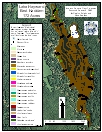Lake Hayward, East Haddam - 2005
2005 Aquatic Plant Survey Map Lake Hayward
Lake Hayward is a 172-acre waterbody with a maximum depth of 35 feet and a mean depth of 11 feet. There are dense residential structures along the shoreline and roads bordering the entire lake. Some residential properties have trees that act as buffers. There are several highly trafficked beaches with many swimmers. Public access to the lake is limited to the boat launch owned by the state at the northern end. Gas motors on boats are prohibited. Lake Hayward has had chemical applications to control invasive plants; fanwort (Cabomba caroliniana) was treated with Fluridone in 2003 and again in 2008.
Our August 2005 survey of the lake showed clusters of aquatic plants along the shoreline with the northern and southern coves heavily vegetated. The cove on the northeastern side of the lake was composed of emergent wetlands species. Two invasives were found in Lake Hayward; fanwortwas found in the northern cove, at the edge of the marsh on the eastern side and as a couple of small patches in a cove on the west side of the lake, and variable-leaf watermilfoil (Myriophyllum heterophyllum) was found along the western side of the lake at depths less than 6 feet. Mudmat (Glossostigma cleistanthum) was found in a large patch on the east side and a small patch on the west side of the lake.
Other species that were found in smaller patches throughout the lake included little floating heart (Nymphoides cordata) on all sides of the lake and needle spikerush (Eleocharis acicularis), white water lily (Nymphaea odorata), and yellow water lily (Nuphar variegata) found in the northern cove, the west side, and the east side of the lake. Purple bladderwort (Utricularia purpurea), common bladderwort (Utricularia macrorhiza), bur-reed (Sparganium species), and spotted pondweed (Potamogeton pulcher) were also found in the northern cove as well as on the west side of the lake. Slender watermilfoil (Myriophyllum tenellum) was only found in the north cove. Slender naiad (Najas flexilis), watershield (Brasenia schreberi), and charaphyte (Chara) were found in the southern cove and the west side of the lake, while sevenangle pipewort (Eriocaulon aquaticum) and an unidentifiable sedge (Carex) were found on the west and east sides. Water plantain (Alisma species) and Robbins' pondweed (Potamogeton robbinsii) were only found on the west side, and small waterwort (Elatine minima) and snailseed pondweed (Potamogeton bicupulatus) were only found on the east side of the lake. Ribbon-Leaf pondweed (Potamogeton epihydrus) was found in both the northern cove and the east side, while small pondweed (Potamogeton pusillus) was found in the southern cove and the east side of the lake.


